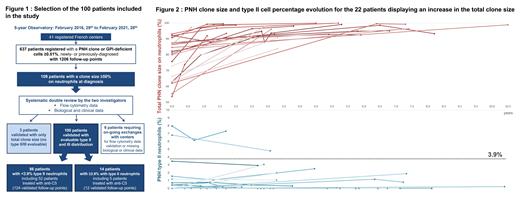Introduction
Flow cytometry (FCM) is the gold standard test to diagnose a PNH clone, type II and III cells being defined by a partial or a complete deficiency, respectively, in GPI-linked proteins. The relevance of classifying type II and type III PNH cells on WBC, unlike their counterparts among red blood cells, remains unknown. Nevertheless, exploring this distinction could hold potential significance for clinical decision-making and patient management. We aimed to assess the distribution of type II and type III cells on WBC in patients displaying a major PNH clone (defined as GPI-deficient neutrophils above 50%) and to investigate their association to clinical presentations.
Methods
The 5-year French nation-wide multicenter observatory (2016-2021) gathered all patients with a diagnosed PNH clone or GPI-deficient cells ≥0.01% on neutrophils, detected in France by FCM. Only patients with a major PNH clone >50% were included in this study. For each patient, the baseline assessment was considered as the initial PNH clone detection, which facilitated long-term follow-up. A referent cytometrist at each center provided clinical and biological information as well as FCM raw data files. This study was approved by the national research ethics board. Fisher, chi-square and ANOVA tests were performed to compare the median values and frequencies.
Results
As of February 28 th, 2021, 41 participating FCM laboratories across France had enrolled 637 patients with a PNH clone or GPI-deficient cells ≥ 0.01%. Among 109 patients displaying a major PNH clone (i.e., ≥ 50%) on neutrophils, 100 patients with distribution of type II and type III cells on neutrophils were validated by the two principal investigators(Figure 1). We performed an AUROC test based on the presence or absence of hemolysis and determined a 3.9% threshold of type II neutrophils. This enabled the distinction of two groups at baseline: 14 patients with high type II cells (7.76%; IQR, 5.63-13.63) and 86 patients with low type II cells (0.05%; IQR, 0.00-0.71; p<0.0001). Besides, type II monocytes were higher in the “high type II” group (6.62%; IQR, 5.30-22.45) compared to the “low type II” group (0.00%; IQR, 0.00-0.71; p<0.0001). However, the total clone size was similar for both groups on WBC (median size on neutrophils: 91.51% (IQR, 80.47-96.90) vs 90.85% (IQR, 79.55-98.20); p=0.79, on monocytes: 89.88% (IQR, 80.27-92.24) vs 91.24% (IQR, 80.59-96.73); p=0.98). The patient median age at diagnosis was 51 years [24-79] for “high type II” group and 40 years [18-85] for “low type II” group and a M/F sex ratio of 1.0 vs 1.3. Diagnoses were confirmed between 2004 and 2021 with clinical information available in 96% of cases. Hemolysis was more frequent in “low type II” group: 96.0% (72/75) compared to “high type II” group: 50.0% (7/14) (p<0.0001) for the 89 patients with available data on hemolysis status, with a trend to more elevated LDH (1289 UI/L; IQR, 553-1931 vs 735 UI/L, IQR: 459-1037; p=0,052) and a reduced clone size on red blood cells (3.26%; IQR, 1.20-32.46 vs 30.48%; IQR, 16.47-45.02; p=0.097). Interestingly, thrombosis appears to be more frequent in “high type II” group: 35.7% (5/14) vs 7.3% (6/82) in the “low type II” group (p<0.01). Bone marrow failure (BMF) without hemolysis (aplastic anemia or MDS) appears to be also more frequent in “high type II” group: 42.9% (6/14) vs 2.7% (=2/75) in the “low type II group” (p=0.0001). All complete blood count parameters, including hemoglobin levels, were not significantly different between the 2 groups.
Among the 62 out of 100 patients who displayed at least one follow-up point, 57 have been treated with anti-C5. Long-term follow-up up to 10.5 years showed that 22 patients displayed an increase in the total clone size (mean: +18.3%, Figure 2), 27 remained stable (+0.3%) and 8 decreased (-29.6%). Interestingly, we did not observe any major modification of type II neutrophil percentages regardless of the total clone size evolution (+0.2%; -0.1%, +0.2%).
Conclusion
This multicenter study based on robust FCM analysis showed for the first time the value of accurate quantification of neutrophil PNH type II cells as patients with high type II cells above 3.9% displayed less hemolysis, more thrombosis and more BMF without hemolysis, which suggests a closer follow-up may be warranted for these patients.
Disclosures
Wagner-Ballon:Novartis: Honoraria; Alexion: Consultancy, Honoraria. Peffault De Latour:Jazz Pharmaceuticals: Honoraria. Amri:Alexion Pharma France: Current Employment. Rongy:Alexion Pharma France: Current Employment. Drenou:Abbvie, Gilead, Janssen: Membership on an entity's Board of Directors or advisory committees; Alexion Pharma France: Honoraria. Debliquis:Alexion Pharma France: Honoraria. Le Garff-Tavernier:Novartis: Honoraria; Janssen: Honoraria; Alexion: Consultancy, Honoraria.


This feature is available to Subscribers Only
Sign In or Create an Account Close Modal